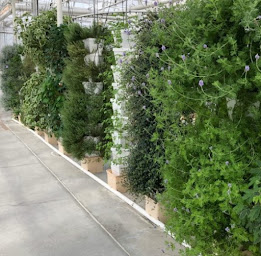This year I noted an increased emphasis on how to manage limited garden space, or creating garden space, and using it to its best advantage. Building lots are smaller, apartment complexes and condos are being built with deck accommodations and the gardening/outdoor living industry is making an effort fulfill those needs.
Vertical planting is becoming of interest to those looking for garden space. Some ideas would include an arbor, trellis system or if space is available a pergola. Fast growing annual vines can be used as a quick screen or to create shade. Flat sided baskets, or window boxes could be attached to a fence to grow small annuals, strawberries and other edibles.Lawns are still a big item on the agenda list of concerns, world-wide, not just central Oregon. Much to my surprise The Royal Horticulture Society in England is an advocate of replacing some of the green lawns and structured formal gardens with pollinator friendly plantings.
I recently read an article asking for advice on how to get rid of 'annoying, pesky plants' in gardens. The writer was referring to Calla lily, anemone or windflower, Love-in-a mist, bluebells; the list went on. It made me realize there is still a great deal of research that needs to be shared with many gardeners on the value of mixed plantings and the value of pollinators. It is a credit to universities and organizations like the Master Gardener programs that teach the value of many so-called weeds to help keep nature in balance.One garden subject that is often neglected is that of garden accessibility for gardeners with limited mobility issues. I noted that this year more considerations and designs are becoming available to address those issues, especially in the establishment of public gardens. Paths need to be flat and paved, if possible. for easy wheelchair accessibility. Ideally the garden area designed with special planters should be close to the Handicap Parking.A raised planting box high enough for wheelchair access was built and installed years ago in the Redmond Demo Garden. However, it wasn't the right time and was not used. Gardening and accessibility has changed greatly over the past ten years. Something as simple as adding bright yellow flowers along pathways or using the small solar garden lights helps guide someone who is sight impaired feel more comfortable.
 Drought continues to be a concern for central Oregon. The more we can improve our native soil with organic matter the sooner we will be able to increase the tilth, the water-holding capacity, of the soil, the sooner we will be able to consider planting some of the 'dry-land' vegetable varieties that are being planting in other parts of Oregon.
Drought continues to be a concern for central Oregon. The more we can improve our native soil with organic matter the sooner we will be able to increase the tilth, the water-holding capacity, of the soil, the sooner we will be able to consider planting some of the 'dry-land' vegetable varieties that are being planting in other parts of Oregon.
There is still so much to learn and so much to share! Happy Planning!





No comments:
Post a Comment
Let us know what you think of Gardening in Central Oregon.